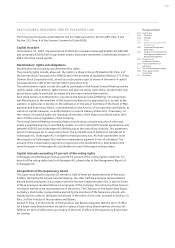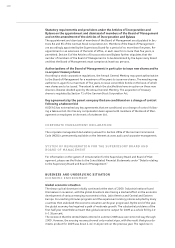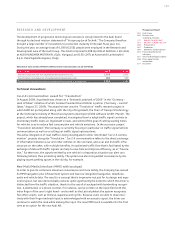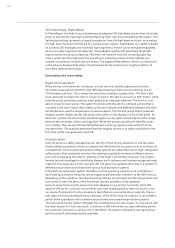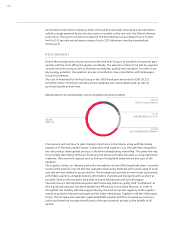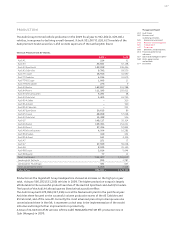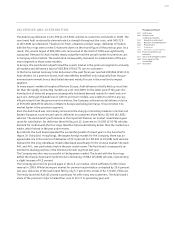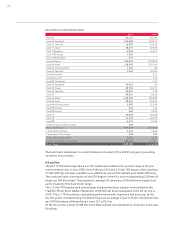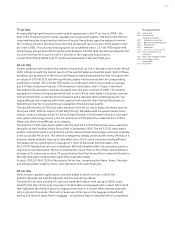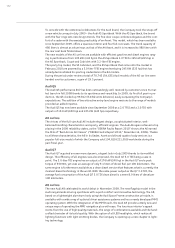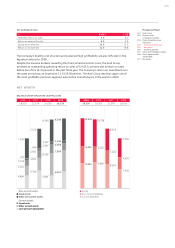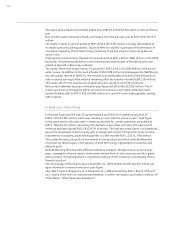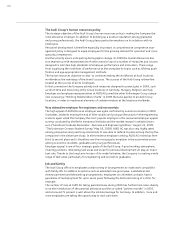Audi 2009 Annual Report Download - page 152
Download and view the complete annual report
Please find page 152 of the 2009 Audi annual report below. You can navigate through the pages in the report by either clicking on the pages listed below, or by using the keyword search tool below to find specific information within the annual report.
149
Management Report
132 Audi Group
140 Business and
underlying situation
140 Economic environment
143 Research and development
146 Procurement
147 Production
149 Deliveries and distribution
153 Financial performance
indicators
157 Social and ecological aspects
168 Risks, opportunities
and outlook
177 Disclaimer
DELIVERIES AND DISTRIBUTION
The Audi Group delivered 1,145,360 (1,223,506) vehicles to customers worldwide in 2009. The
core brand Audi continued to demonstrate its strength throughout the crisis, with 949,729
(1,003,469) cars delivered. Thanks to its fresh, attractive product range, deliveries of models
with the four rings were a mere 5.4 percent down on the record figure of the previous year. As a
result, the volume target of 900,000 units announced at the start of 2009 was significantly
surpassed. Demand for Audi models clearly outperformed the overall market for premium cars
in many key sales markets. The Audi brand consequently increased its market share of the pre-
mium segment in those same markets.
In Europe, the Audi brand outperformed the overall market in the premium segment in virtually
all markets and delivered a total of 618,854 (709,677) cars to customers.
In the home market Germany, total deliveries in the past fiscal year reached 228,844 (258,111)
Audi vehicles. As a premium brand, Audi nevertheless benefited only marginally from the gov-
ernment environment bonus that fueled demand mainly for cars in the small and compact
segment.
In many export markets throughout Western Europe, Audi deliveries initially held up much bet-
ter than the rapidly contracting markets up until mid-2009. In the latter part of the year, the
introduction of state aid programs subsequently bolstered demand mainly for small and com-
pact cars. Although the Audi brand, with its premium models, was unable to profit to any sig-
nificant extent from the government incentives, the Company achieved a total delivery volume
of 359,465 (408,873) vehicles in Western Europe (excluding Germany). This promoted it to
market leader in the premium segment.
Even the Audi brand was not entirely immune to the sharply contracting markets in Central and
Eastern European countries and saw its deliveries to customers there fall to 30,545 (42,693)
vehicles. The Audi brand’s performance in the important Russian car market nevertheless gave
cause for satisfaction. Its deliveries there fell by just 12.1 percent to 15,009 (17,076) vehicles;
demand for models with the four rings therefore fared substantially better than the market as a
whole, which halved in the year under review.
By contrast, the Audi brand repeated the successful growth of recent years in the Asia-Pacific
region. In China (incl. Hong Kong), the largest foreign market for the Company, there was an
appreciable rise in the volume of deliveries of 32.9 percent to 158,941 (119,598) Audi vehicles.
Demand for the long-wheelbase models developed specifically for the Chinese market, the Audi
A4 L and A6 L, was particularly high in the year under review. The Audi brand consequently ce-
mented its leading position in the Chinese premium segment last year.
The Company was also very successful in the Japanese market. The brand with the four rings
defied the sharply downward market trend in delivering 15,854 (15,800) vehicles, representing
a slight increase of 0.3 percent.
The Company also held its ground again in the U.S. car market, which suffered a further sharp
reversal in 2009. While the import market for premium automobiles contracted by 19.6 percent
last year, deliveries of the Audi brand fell by only 5.7 percent to a total of 82,716 (87,760) cars.
The newly launched Audi Q5 proved a particular hit with many new customers. The Audi brand’s
share of the premium import market thus rose to 8.3 (7.1) percent by year-end.


